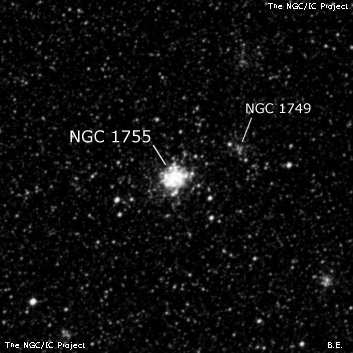
James Dunlop discovered NGC 1755 = D 167 = h2706 on 3 Oct 1826 with his 9" reflector and described a "pretty bright round well-defined nebula, 15 arcsec diameter." Dunlop made two observations and his position is 7' west of center. John Herschel made a single observation on 30 Dec 1836 and recorded "very bright, round, gradually brighter in the middle; 60". The following of two [with NGC 1749] in the field."
Pietro Baracchi observed NGC 1755 and NGC 1749 on 10 Dec 1884 with the 48" Melbourne telescope. His sketch shows NGC 1755 as very mottled with a distinct star at the south edge and another at the northwest edge. At the same time he discovered S-L 92, an extremely faint cluster 5' SW. He wrote in his notebook, "Nebula not in Calalogues. Very faint, a little elongated, no condensation." The discovery was not published.
400/500mm - 18" (7/9/02 - Magellan Observatory, Australia): bright, compact cluster, round, 1.5' diameter, brighter core, no resolution. Forms a pair with much fainter NGC 1749 2' NW.
Notes by Steve Gottlieb